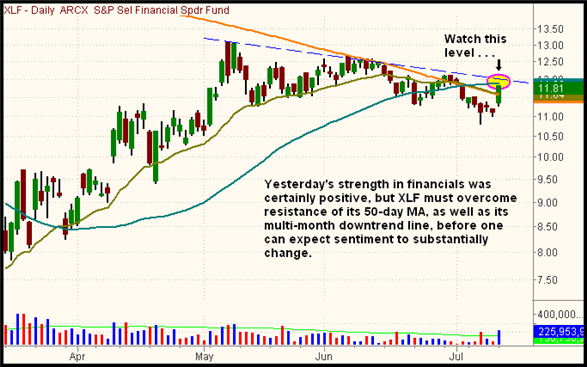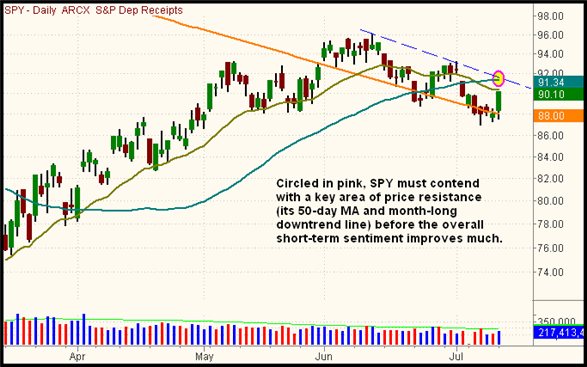|
The Wagner Daily ETF Report For July 14
After several days of tight-ranged, low-volatility trading, stocks woke up yesterday. Led by a surge in the financial sector, all the major indices logged sizeable gains of more than 2%, as higher turnover accompanied the rally. The S&P 500 jumped 2.5%, the Dow Jones Industrial Average 2.3%, and the Nasdaq Composite 2.1%. The small-cap Russell 2000 and S&P Midcap 400 indices motored to gains of 2.5% and 2.4% respectively. Each of the main stock market indexes closed at its absolute best level of the day.
Total volume in the NYSE swelled 29%, while volume in the Nasdaq rose 13% above the previous day's level. The broad-based gains on higher volume enabled both the S&P 500 and Nasdaq Composite to register a bullish "accumulation day." Given the numerous sessions of higher volume losses in recent weeks, yesterday's indication of buying amongst mutual funds, hedge funds, and other institutions was encouraging. Nevertheless, despite the faster pace of trading, turnover in both exchanges remained below 50-day average levels. Very strong market internals matched the gains of the major indices. In the NYSE, advancing volume trounced declining volume by a margin of nearly 10 to 1. The Nasdaq adv/dec volume ratio was positive by more than 5 to 1.
For months, the broad market has lived and died by the performance of the financial sector, perhaps assumed by many to be an indicator of the overall economy's health. When stocks rallied from March through June of 2009, the gains in the broad market were primarily led by financial stocks. Then, in mid-June, it was the sudden showing of relative weakness in financials that sparked the current correction in the major indices. As such, it's not surprising that yesterday's 6.5% gain in the Banking Index ($BKX) was one of the main reasons for the rather substantial gains in the main stock market indexes. The big question, however, is whether or not yesterday's rally in the financial sector was merely a bounce from "oversold" conditions. To prove it was the start of an actual, sustainable recovery, not just a bounce that will quickly fizzle out, financial stocks have a lot of resistance to overcome in the coming days. Check out the daily chart of the S&P Financial SPDR (XLF), an ETF proxy for the technical state of the financial sector:

On the chart above, the dashed blue line marks pivotal resistance of a downtrend line that's been in place for the past several months. Just below that, above yesterday's close, is the 50-day moving average (the teal line), also a key level of intermediate-term resistance. If XLF manages to firmly close above that downtrend line, not just probe above it on an intraday basis, overall sentiment in the financial sector could change very quickly, pulling the entire stock market along with it. But until that happens, it would be unwise to get too excited about yesterday's gains in the financial sector. The immediate reaction to the latest earnings report from financial leader, Goldman Sachs (GS), due in today's pre-market, will play a large part in determining what happens next.
In yesterday's commentary, we said, "The S&P, Dow, and Nasdaq are all below their 50-day moving averages, while the S&P struggles to cling to its 200-day moving average. While it's positive the S&P 500 is showing resilience at pivotal support of its 200-day moving average, the most important point is the index remains below the "neckline" of its dominant head and shoulders pattern, which we've discussed numerous times over the past two weeks. Unless that situation changes, one could expect a continued neutral to downward bias in the short-term of the broad market." Unfortunately for the bulls, yesterday's strength did not change this technical situation very much. Only the Nasdaq reclaimed its 50-day moving average, and the Dow still remains below its 200-day moving average. The S&P and Dow moved above the bottom of their "necklines," but the dominant "head and shoulders" patterns remain in effect. Only a convincing rally above the high of the right shoulders would have significant bullish implications, as that would also correlate to a breakout above the month-long downtrend lines that have developed in the S&P and Dow. Below is a daily chart of the S&P 500 SPDR (SPY), a popular ETF proxy for the benchmark S&P 500 Index:

Notice how SPY's month-long downtrend line (the dashed blue line) neatly converges with its 50-day moving average (the teal line). All eyes should be focused on this convergence point, around the $91.25 to $91.50 area (910 to 915 in the S&P 500), as it is a key area of resistance that could determine the outcome of the market's short-term direction. Because of the plethora of overhead supply the major indices must now contend with, it's critical the broad market quickly follows through on yesterday's strength, pushing the S&P back above its 50-day moving average and month-long downtrend line. Otherwise, it would not take much additional selling pressure for stocks to slide back down to last week's lows.
Fortunately, we closed most of our "short ETFs" for nice gains at the end of last week. Going into yesterday, just one "short ETF" remained, UltraShort Dow 30 ProShares (DXD). However, because we trailed the stop higher to protect against a sudden reversal, we still closed the trade with a gain of more than 2 points yesterday. That leaves us only with open positions in iPath India Index (INP) and iShares 20+ year T-Bond (TLT). If stocks build on yesterday's bullish momentum, causing the main stock market indexes to overcome key resistance levels, we'll be ready to selectively jump back into the long side of the market, focused on ETFs with the most relative strength. But just in case yesterday's rally fades away over the next few days, we're taking a cautious stance by remaining primarily in cash until the market shows its hand. Remember to "trade what you see, not what you think!"
Open ETF positions:
Long - INP, TLT
Short - (none)
Deron Wagner is the Founder and Head Trader of both Morpheus Capital LP, a U.S. hedge fund, and MorpheusTrading.com, a trader education firm.
|